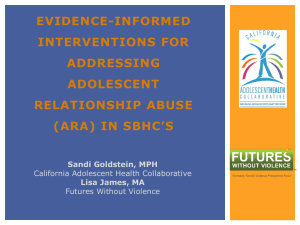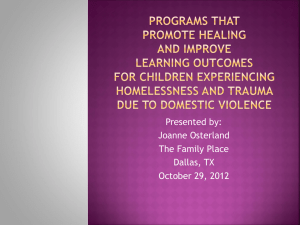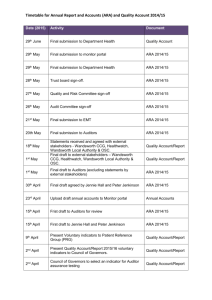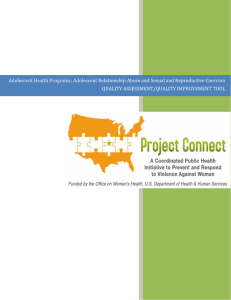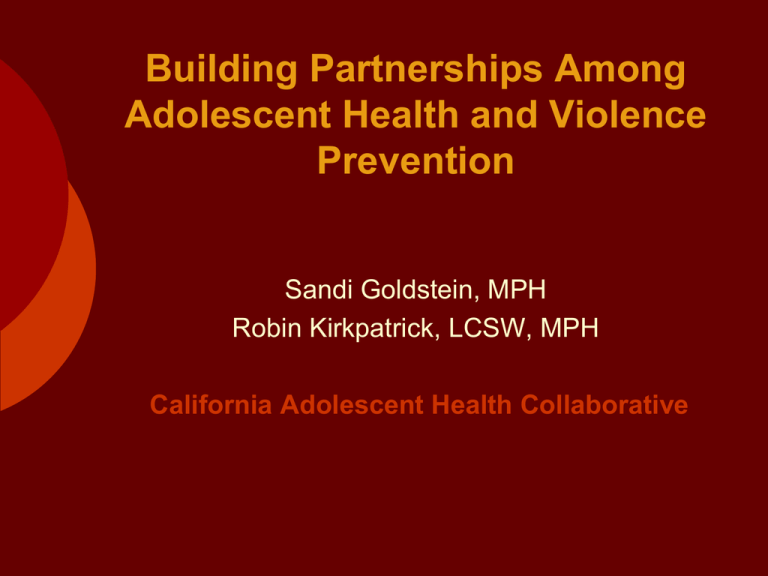
Building Partnerships Among
Adolescent Health and Violence
Prevention
Sandi Goldstein, MPH
Robin Kirkpatrick, LCSW, MPH
California Adolescent Health Collaborative
What is adolescent relationship
abuse?
Adolescent relationship abuse (ARA) refers to an
escalating pattern of repeated acts that physically,
sexually, or emotionally abuse a member of a
heterosexual or homosexual couple in which one or
both partners is a minor.
Range of controlling behaviors: monitoring cell
phone usage, telling a partner what s/he can wear,
controlling where s/he goes, and manipulating
contraceptive use.
ARA is often minimized by adults.
Adolescent Relationship Abuse:
Why is it important?
Retrospective studies suggest that
patterns of battering in adolescent
relationships may be reproduced in
partner abuse in adulthood
Few adolescents report experiences of
violence to adults, and adolescents make
up a small proportion of clients utilizing
domestic violence services. (Foshee et. al,
2000)
Health Consequences of ARA
Studies have found that victims of physical
and sexual dating violence were more
likely to:
engage in substance use
more likely to report sadness,
hopelessness or suicide ideation,
more likely to use vomiting for weight
loss,
more likely to carry weapons and
engage in physical fighting.
ARA and Sexual Risk for Adolescents
Partner violence among teen girls linked
with: (Silverman et al. 2004) [YRBS data]
Early sexual intercourse (before age 15)
Condom non-use at last sex
Multiple partnering (3+) in past 3 months
Pregnancy
ARA and Sexual Risk for Adolescents
(cont.)
Girls reporting IPV 3 times more likely to
have been tested for STI/HIV and 2.6
times more likely to report STI diagnosis
(Decker et al. 2005)
Coercive sexual experiences linked to
HPV infection and cervical dysplasia (Kahn
et al. 2005)
Intimate Partner Violence (IPV)
and Pregnancy
Teens in abusive
relationships are 4-10
times more likely to
become pregnant than
non-abused teens.
Pregnant adolescents 2-3
times more likely to have
experienced violence
during and after pregnancy
than older pregnant
women
Voices of Youth
“He [used condoms] when we first
started, and then he would fight with me
over it, and he would just stop [using
condoms] completely, and didn't care. He
got me pregnant on purpose, and then he
wanted me to get an abortion….”
Voices of Youth (cont’d)
“I was on the birth control, and I was still taking
it, and he ended up getting mad and flushing it
down the toilet, so I ended up getting pregnant.
I found out that [before this] he talked to my
friends and he told them that we were starting a
family. I didn't know that. I didn't want to start a
family. I wanted to finish school.”
Miller E, Decker MR, Reed E, Raj A, Hathaway J, Silverman JG. Male Partner Pregnancy Promoting Behaviors
and Adolescent Partner Violence: Findings From a Qualitative Study With Adolescent Females. Ambulatory
Pediatrics 2007;7:360-66.
Partner Violence and Reproductive
Coercion
Key Findings from first quantitative study of IPV, reproductive
coercion, and unintended pregnancy:
Approximately 1 in 5 young women said they experienced
pregnancy coercion
15% said they experienced birth control sabotage
53% of respondents said they experienced physical or
sexual violence from and partner
35% of the young women who reported partner violence
also reported either pregnancy coercion or birth control
sabotage.
Elizabeth Miller, Michele R. Decker, Heather L. McCauley, Daniel J. Tancredi, Rebecca R. Levenson, Jeffrey Waldman, Phyllis
Schoenwald, Jay G. Silverman. Pregnancy coercion, intimate partner violence and unintended pregnancy , Contraception
April 2010 (Vol. 81, Issue 4, Pages 316-322)
Clinic-based Survey IPV Prevalence
Adolescent Females Utilizing
Teen Clinics
N=448
Sexual violence in intimate
relationship (insisted, threatened,
physical force to have sex)
21.2%
Physical violence in intimate
relationship (includes hit, choked,
used knife or gun against)
31.9%
Physical and/or sexual violence ever
in relationship
40.0%
Healthcare Providers’ Role:
Needs Assessment
Key Findings from needs assessment of health care
providers working in school health centers.
While 33% of the providers reported screening their
adolescent clients for ARA all of the time, 34% reported
that they are unsure how to ask questions.
Providers reported feeling uncomfortable asking
questions about ARA when the visit appeared
not to be violence related.
Additional barriers:
√ Time
√ Mandated reporting requirements
√ Not sure what questions to ask
√ Partner present for visit
Healthcare Providers’ Role in ARA
Provider
interventions can have a
significant effect on teens’
knowledge, skills, and health behavior
Opportunity
for assessment and
intervention
Chances
to provide education around
a sensitive topic in the course of
routine care
Healthcare Providers’ Role in ARA
(cont’d)
Encourage
adolescent
recognition of ARA in their lives
and lives of their peers
Increase
knowledge of ARA
resources available
Ensure
that adolescent-friendly,
confidential, inclusive clinic
practice in place
The Healthcare Education, Assessment &
Response Tool for Teen Relationships
(HEART) Primer & Training
A collaborative project of:
California Adolescent Health Collaborative, a
project of the Public Health Institute
UC Davis School of Medicine
Family Violence Prevention Fund
Program Goals
Develop and produce HEART Primer and Training to
assess and screen for ARA in clinic settings to:
decrease the incidence of ARA among California
youth through improved case identification and
clinic based interventions
increase teen health and safety by promoting
healthy relationships, and
improve healthcare systems capacity to prevent
ARA
Community Linkages
A Team Approach is Beneficial
Providers should not feel that they must have
“all the answers.” In these moments, having a
team in place to call upon is necessary so the
provider is not left carrying the weight of the
situation alone.
Community Linkages (cont’d)
Information on where employees in abusive
relationships can access assistance
Consultation with on-site or off-site:
• ARA advocates
• legal and forensic
experts
• counselors with
expertise in trauma
treatment
• experts from diverse
(LGBT, disability, teen,
ethnic specific and
immigrant) communities
• Local rape crisis centers
Community Linkages (cont’d)
Other Common resources may include:
Local community domestic violence programs that
offer advocacy, groups, training, and shelter services
Domestic violence specialist within the police
department in cases where a young person might need
a restraining order or other legal intervention
The child protection service may also have a domestic
violence unit and can assist in balancing services for the
minor as well as the provider’s role as a mandated
reporter.
How can HEART support your
work?
Train community Providers to use
HEART Primer as a mechanism for
engaging that healthcare
community with dv community.
For More Information
California Adolescent Health Collaborative
555 12th Street, 10th Floor
Oakland, California 94607
510.285.5712
sandig@californiateenhealth.org
robink@californiateenhealth.org
www.californiateenhealth.org


